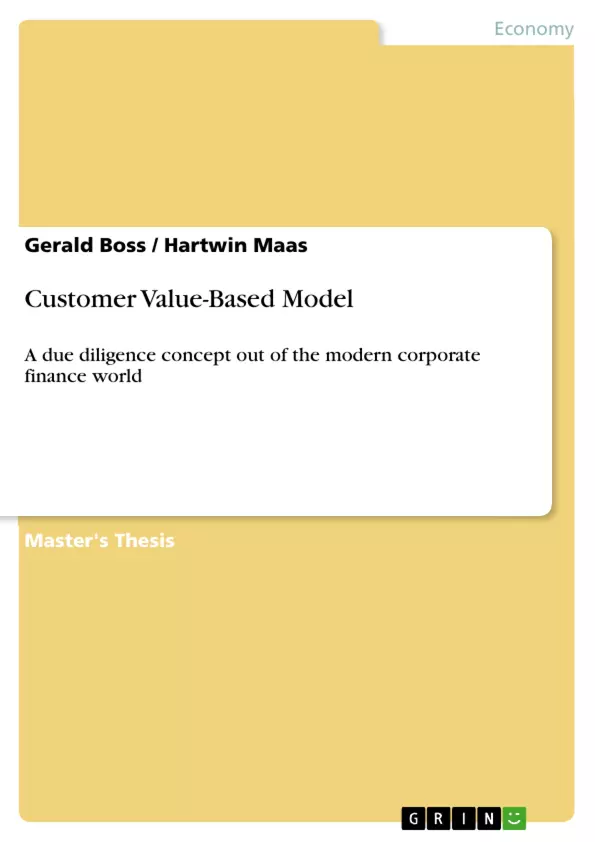The master thesis presents the derivation of the Customer Value-Based Model (CVM) which stands for a new approach for a solid corporate valuation. The CVM is a comprehensive tool for supporting strategic decision making processes and corporate valuation. It synthesizes a holistic view which takes strategic and operational management levels into consideration and establishes a financing-marketing interface. It connects the value of the customer base as a main focus of marketing activities with the corporate value as measurement of the financial success of the company. A further advantage is that the success of marketing activities can also be viewed from the shareholder value perspective. Hence, the model helps to estimate the commitment of marketing to the total performance of the company.
The CVM is applied by a Volvo car retailer in the Netherlands. The car retail business is basically distinguishing between customer services which indicate that the customer should be the most risky asset for a company. Four subsidiaries belong to the Dutch car dealer which are analyzed within this master thesis and valuated by the CVM.
Inhaltsverzeichnis (Table of Contents)
- Executive Summary
- Phase I: Theoretical Establishment of the CVM
- Phase II: Marketing & Research Analysis
- Phase III: Financial Analysis
- Phase IV: Utilization of the CVM
- Computation of Corporate Value by CVM
- Strategy Formulation
- Recommendation & Conclusion
- Glossary
Zielsetzung und Themenschwerpunkte (Objectives and Key Themes)
This master thesis aims to develop and apply the Customer Value-Based Model (CVM) as a comprehensive tool for corporate valuation and strategic decision-making. The CVM integrates marketing and finance perspectives, focusing on the value of the customer base in relation to corporate value.- Derivation of the Customer Value-Based Model (CVM)
- Application of the CVM to a Volvo car retailer in the Netherlands
- Integration of marketing and finance perspectives in corporate valuation
- Assessment of the impact of customer retention on corporate value
- Development of strategic recommendations for improving customer retention
Zusammenfassung der Kapitel (Chapter Summaries)
- Executive Summary: This section provides a concise overview of the master thesis, outlining the CVM, its application to a Volvo car retailer, and the key findings.
- Phase I: Theoretical Establishment of the CVM: This chapter establishes the theoretical foundation of the CVM, outlining its key components and how it connects customer value to corporate value.
- Phase II: Marketing & Research Analysis: This chapter presents the analysis of the Volvo car retailer's marketing strategy and market environment, gathering data on customer retention, reference value, market share, and competitor analysis. This phase lays the groundwork for the subsequent financial analysis.
- Phase III: Financial Analysis: This chapter dives into the financial analysis of each subsidiary, providing key financial data such as Return on Invested Capital (ROIC), Weighted Average Cost of Capital (WACC), and present value of accumulated reinvestments. This data is crucial for calculating the corporate value using the CVM.
- Phase IV: Utilization of the CVM: This chapter demonstrates the practical application of the CVM. It calculates the corporate value for each subsidiary by computing Customer Lifetime Value (CLV) and Customer Equity (CE). It also develops a strategic framework for each branch, identifying the most attractive strategy based on the CVM results.
Schlüsselwörter (Keywords)
The primary keywords and focus topics of this thesis include customer value, corporate valuation, customer lifetime value, customer equity, customer retention, strategic decision-making, and marketing-finance integration. The CVM serves as a crucial tool for analyzing and improving the financial performance and strategic direction of the car retail business.- Quote paper
- Mag. (FH), MIB Gerald Boss (Author), Dipl.-Wirtsch.-Ing, MIB Hartwin Maas (Author), 2005, Customer Value-Based Model, Munich, GRIN Verlag, https://www.grin.com/document/210178



